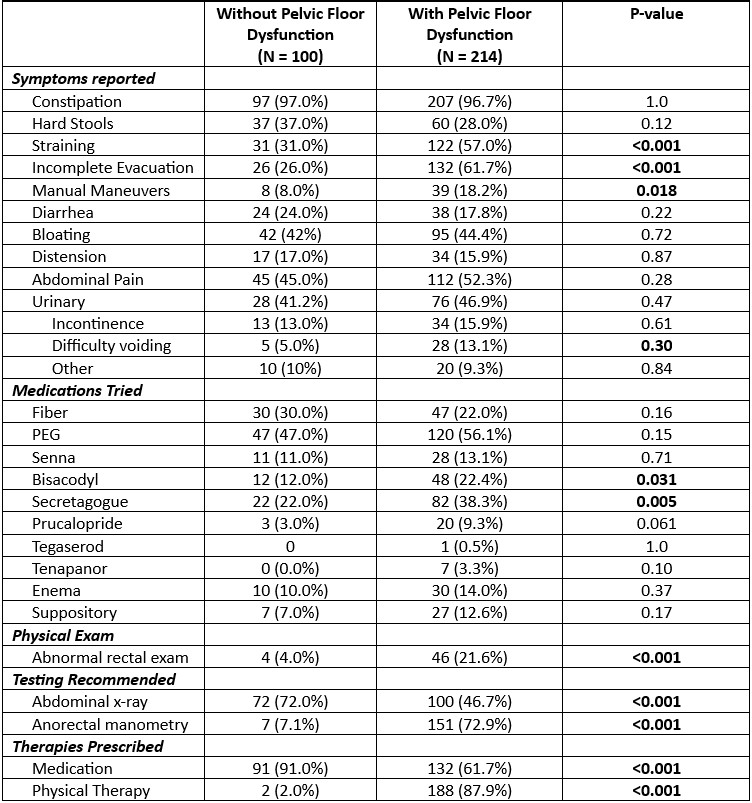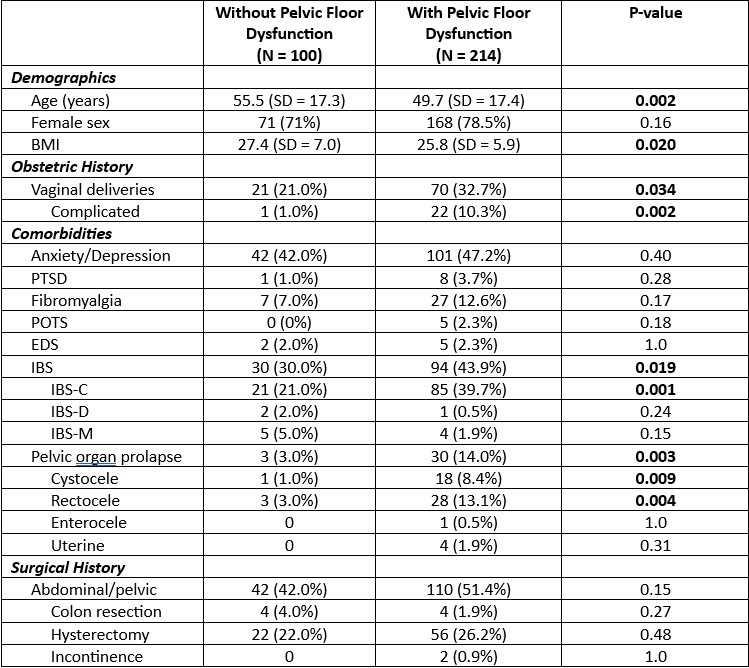Sunday Poster Session
Category: Colon
P0296 - Pelvic Floor Dysfunction Is a Common Cause of Chronic Constipation: A Retrospective Review of Patients Referred to a Tertiary Center for Constipation
Sunday, October 26, 2025
3:30 PM - 7:00 PM PDT
Location: Exhibit Hall

Jessica C. Petrov, MD, MSc (she/her/hers)
Mayo Clinic
Jacksonville, FL
Presenting Author(s)
Jessica C. Petrov, MD, MSc, Shanya Arasu, , David J.. Cangemi, MD
Mayo Clinic, Jacksonville, FL
Introduction: Pelvic floor dysfunction (PFD) is a common, yet underrecognized cause of chronic constipation. A delay in diagnosing PFD can lead to patient dissatisfaction and increased healthcare costs. Our aim was to evaluate rates and predictors of PFD in patients referred for tertiary evaluation of chronic constipation.
Methods: This was a retrospective study of patients referred to Mayo Clinic Florida for constipation between 9/2023 and 5/2024. Baseline characteristics, testing, final diagnosis, and recommended treatments were recorded. Continuous variables were summarized as median (range) and mean (SD) and categorical variables were reported as frequency (%). Continuous variables were compared using Wilcoxon rank sum test and categorical variables were compared using Fisher’s exact test.
Results: Among the 314 patients included in the final analysis, 68.2% (n = 214) were diagnosed with PFD. Patients diagnosed with PFD were significantly younger (mean age 49.7 years vs. 55.5, p = 0.002) and more often had one or more vaginal delivery (32.7% vs. 21.0%, p = 0.034), particularly complicated vaginal deliveries (10.3% vs. 1.0%, p = 0.002; Table 1). Patients with PFD also more often had pelvic organ prolapse (14.0% vs. 3.0%, p = 0.003) and IBS-C (39.7% vs. 21.0%, p = 0.001). There were no significant differences in gender, psychiatric comorbidities, or abdominal/pelvic surgeries between the two groups. Patients with PFD more often reported straining (57.0% vs. 31.0%, p< 0.001), a sensation of incomplete evacuation with defecation (61.71% vs. 26%, p< 0.001), need for manual maneuvers (18.2% vs. 8.0%, p=0.018), and difficulty voiding urine (13.1% vs. 5.0%, p=0.30; Table 2). Patients with PFD were more likely to have previously been treated with secretagogues (38.3% vs. 22.0%, p=0.005). Rectal exam was more often abnormal (21.6% vs. 4.0%, p< 0.001). Finally, pelvic floor physical therapy was more often recommended in patients with PFD (87.9% vs. 2.0%, p< 0.001), while medications were more often prescribed in patients without PFD (91.0% vs. 61.0%, p< 0.001).
Discussion: The majority of patients referred for tertiary evaluation of chronic constipation were diagnosed with PFD. PFD is more common in younger patients with a history of complicated vaginal delivery, pelvic organ prolapse, IBS-C, and in patients reporting straining, incomplete evacuation, the use of manual maneuvers, and difficulty voiding urine. A rectal examination can help to distinguish patients with PFD.

Figure: Table 1: Baseline Characteristics
BMI = body mass index; PTSD = post traumatic stress disorder; POTS = postural orthostatic tachycardia syndrome; EDS = Ehlers-Danlos Syndrome; IBS = irritable bowel syndrome (C = constipation, D = diarrhea, M = mixed)

Figure: Table 2: Diagnostic Evaluation
PEG = polyethylene glycol
Disclosures:
Jessica Petrov indicated no relevant financial relationships.
Shanya Arasu indicated no relevant financial relationships.
David Cangemi indicated no relevant financial relationships.
Jessica C. Petrov, MD, MSc, Shanya Arasu, , David J.. Cangemi, MD. P0296 - Pelvic Floor Dysfunction Is a Common Cause of Chronic Constipation: A Retrospective Review of Patients Referred to a Tertiary Center for Constipation, ACG 2025 Annual Scientific Meeting Abstracts. Phoenix, AZ: American College of Gastroenterology.
Mayo Clinic, Jacksonville, FL
Introduction: Pelvic floor dysfunction (PFD) is a common, yet underrecognized cause of chronic constipation. A delay in diagnosing PFD can lead to patient dissatisfaction and increased healthcare costs. Our aim was to evaluate rates and predictors of PFD in patients referred for tertiary evaluation of chronic constipation.
Methods: This was a retrospective study of patients referred to Mayo Clinic Florida for constipation between 9/2023 and 5/2024. Baseline characteristics, testing, final diagnosis, and recommended treatments were recorded. Continuous variables were summarized as median (range) and mean (SD) and categorical variables were reported as frequency (%). Continuous variables were compared using Wilcoxon rank sum test and categorical variables were compared using Fisher’s exact test.
Results: Among the 314 patients included in the final analysis, 68.2% (n = 214) were diagnosed with PFD. Patients diagnosed with PFD were significantly younger (mean age 49.7 years vs. 55.5, p = 0.002) and more often had one or more vaginal delivery (32.7% vs. 21.0%, p = 0.034), particularly complicated vaginal deliveries (10.3% vs. 1.0%, p = 0.002; Table 1). Patients with PFD also more often had pelvic organ prolapse (14.0% vs. 3.0%, p = 0.003) and IBS-C (39.7% vs. 21.0%, p = 0.001). There were no significant differences in gender, psychiatric comorbidities, or abdominal/pelvic surgeries between the two groups. Patients with PFD more often reported straining (57.0% vs. 31.0%, p< 0.001), a sensation of incomplete evacuation with defecation (61.71% vs. 26%, p< 0.001), need for manual maneuvers (18.2% vs. 8.0%, p=0.018), and difficulty voiding urine (13.1% vs. 5.0%, p=0.30; Table 2). Patients with PFD were more likely to have previously been treated with secretagogues (38.3% vs. 22.0%, p=0.005). Rectal exam was more often abnormal (21.6% vs. 4.0%, p< 0.001). Finally, pelvic floor physical therapy was more often recommended in patients with PFD (87.9% vs. 2.0%, p< 0.001), while medications were more often prescribed in patients without PFD (91.0% vs. 61.0%, p< 0.001).
Discussion: The majority of patients referred for tertiary evaluation of chronic constipation were diagnosed with PFD. PFD is more common in younger patients with a history of complicated vaginal delivery, pelvic organ prolapse, IBS-C, and in patients reporting straining, incomplete evacuation, the use of manual maneuvers, and difficulty voiding urine. A rectal examination can help to distinguish patients with PFD.

Figure: Table 1: Baseline Characteristics
BMI = body mass index; PTSD = post traumatic stress disorder; POTS = postural orthostatic tachycardia syndrome; EDS = Ehlers-Danlos Syndrome; IBS = irritable bowel syndrome (C = constipation, D = diarrhea, M = mixed)

Figure: Table 2: Diagnostic Evaluation
PEG = polyethylene glycol
Disclosures:
Jessica Petrov indicated no relevant financial relationships.
Shanya Arasu indicated no relevant financial relationships.
David Cangemi indicated no relevant financial relationships.
Jessica C. Petrov, MD, MSc, Shanya Arasu, , David J.. Cangemi, MD. P0296 - Pelvic Floor Dysfunction Is a Common Cause of Chronic Constipation: A Retrospective Review of Patients Referred to a Tertiary Center for Constipation, ACG 2025 Annual Scientific Meeting Abstracts. Phoenix, AZ: American College of Gastroenterology.
